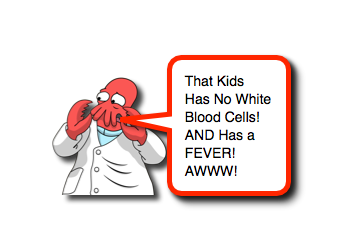Originally published at Pediatric EM Morsels on May 19, 2017. Reposted with permission.
Follow Dr. Sean M. Fox on twitter @PedEMMorsels
 We all are well aware of the prevalence “fever” as a presenting complaint. We are also well aware that not all “cc: fever” are created equal. Fever in a neonate may be due to a virus, but we can’t bet on it. Fever in the patient with delayed cap refill requires more contemplation than what is the maximum dose of antipyretic. Fever in a patient with sickle cell disease warrants special attention. While, generally, I have a disdain for making medical decisions based heavily on the WBC count (“WBC count is the Last Bastion of the Intellectually Destitute” – Dr. Amal Mattu @amalmattu), there are conditions that mandate respect for the WBC, like leukemia and childhood cancers. Let us take a minute to review the current recommendations for initial management of Neutropenic Fever:
We all are well aware of the prevalence “fever” as a presenting complaint. We are also well aware that not all “cc: fever” are created equal. Fever in a neonate may be due to a virus, but we can’t bet on it. Fever in the patient with delayed cap refill requires more contemplation than what is the maximum dose of antipyretic. Fever in a patient with sickle cell disease warrants special attention. While, generally, I have a disdain for making medical decisions based heavily on the WBC count (“WBC count is the Last Bastion of the Intellectually Destitute” – Dr. Amal Mattu @amalmattu), there are conditions that mandate respect for the WBC, like leukemia and childhood cancers. Let us take a minute to review the current recommendations for initial management of Neutropenic Fever:
Neutropenic Fever: Basics
- Neutropenia definitions can vary between institutions. [White, 2014]
- Typical definition = Absolute Neutrophil Count (ANC) < 1500 cell/microL
- Severe neutropenia is ANC < 500
- Patients receiving chemotherapy are at high risk for morbidity and mortality due to infections! [Cohen, 2016]
- The reduced immune system may lead these patients to present with limited or atypical signs of illness.
- Fever may be the only sign of significant infection.
- Neutropenic fever is one of the most common and serious complicationsthat occurs during chemotherapy. [Lehrnbecher, 2017;Klastersky, 2016]
Low vs High Risk?
- There are a number of scoring systems used to assess a patient’s risk of bacteremia and morbidity/mortality. [Lehrnbecher, 2017]
- None of them are universally agreed upon. [Lehrnbecher, 2017; Cohen, 2016]
- There are 6 clinically based low-risk stratification strategies.
- All still require local validation. [Lehrnbecher, 2017]
- Factors known to increase risk:
- Chemotherapeutic regimen
- Advanced disease or progressive disease
- AML, ALL, Burkitt lymphoma, and relapsed acute leukemia
- History of hematopoietic stem-cell transplantation
- History of prior febrile neutropenia
- Use of high dose corticosteroids
- Presence of a focal site of infection (ex, pneumonia, abscess)
- Presence of central venous access
- Mucositis
- Absolute Monocyte Count <100/microL
Neutropenic Fever: ED Evaluation
- While signs and symptoms may be minimal, there presence is important!
- Search for:
- Complaints of chills or rigors
- Hypotension
- Poor Perfusion
- A Source!
- Mucositis
- Abscess
- Pulmonary
- Urinary tract
- GI tract
- Perineal region infection
- Necrotizing Fasciitis (localized pain out of proportion) [Johnston, 2001]
- CNS infection
- Don’t skimp on the labs!
- CBC with differential (obviously, need this to confirm neutropenia)
- Blood cultures
- From all lumens of central line
- May also obtain peripheral culture as this can increase the detection of true bacteremia by 12%, but must be weighed against risk of contamination and pain. [Lehrnbecher, 2017]
- Cultures of other potential sources
- Urinalysis and Urine Culture, even if asymptomatic [Lehrnbecher, 2017; Sandoval, 2012]
- Basic electrolyte panel
- Chest Xray only for patients with pulmonary signs/symptoms. [Lehrnbecher, 2017; Roberts, 2012]
Neutropenic Fever: Initial Management
- DON’T JUST WAIT, RESUSCITATE!
- Again, being aware that chemotherapy may lead to subtle presentations, the patient/family may not become alert to illness until the child is much sicker.
- IV or IO boluses fluids if perfusion is poor or hypotension present.
- Empiric broad spectrum dual therapy antibiotics
- Antipseudomonal Beta-Lactam, 4th generation cephalosporin, or carbapenem PLUS a second gram-negative agent or a glycopeptide for the clinically unstable is recommended. [Lehrnbecher, 2017]
- Dual coverage is also recommended if a resistant infection is suspected. [Lehrnbecher, 2017]
- Ex: Cefepime AND Aminoglycoside AND Vancomycin
- Tailor to the patient’s prior culture results and hospital resistance patterns
- Early use of pressors if need be.
- IF THE CHILD LOOKS WELL, DON’T BE CAVALIER!
- Again, presentation can be subtle in these patients with non-functioning immune systems.
- Having a institutional protocol for evaluation and management of pediatric neutropenic fever can help expedite care and decrease time to antibiotic administration. [Cohen, 2016; Cash, 2014]
- Obtain labs, including cultures and give empiric antibiotics.
- If the child looks well, then empiric mono-therapy is recommended. [Lehrnbecher, 2017; Chuang, 2002]
- If there is a documented neutropenia in the last 24 hours, treat empirically with monotherapy antibiotics (ex, Cefepime).
- Due to the high incidence of infections with patients presenting with neutropenic fever, some advocate for giving empiric antibiotics even prior to confirmation of neutropenia in patients with: [Cohen, 2016]
- Active Chemotherapy regimens (or off less than 1 month) OR
- History of congenital or acquired neutropenia not related to chemo.
- Some children will be able to go home on oral antibiotics, but this will be contingent upon assessment of being “low risk” with the Oncologist. [Lehrnbecher, 2017]
Moral of the Morsel
- Don’t be fooled. The patient with no immune system deserves significant respect and requires our vigilance.
- Be thorough.Where is the source? Look at the mucous membranes and consider necrotizing fasciitis (i.e., look in the perineum)!
- Be aggressive! If the child looks sick, throw all of the antibiotics at them. If the child looks well, mono-therapy is recommended.
- High Risk vs Low Risk… don’t decide alone. Your physical exam and lab results will help determine whether a patient is high risk or low risk, but that determination should be made concurrently with the patient’s oncologist.





